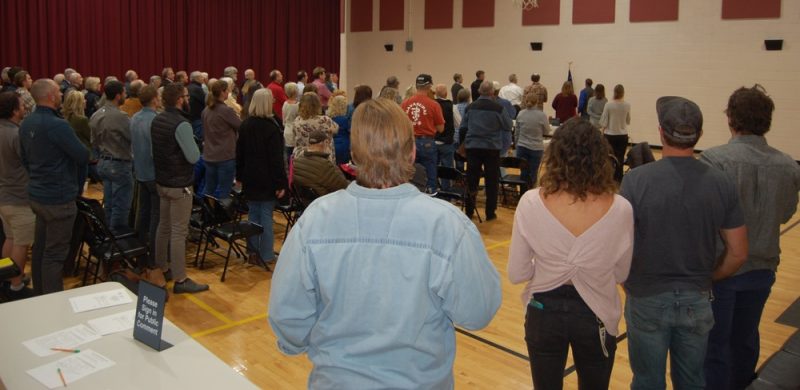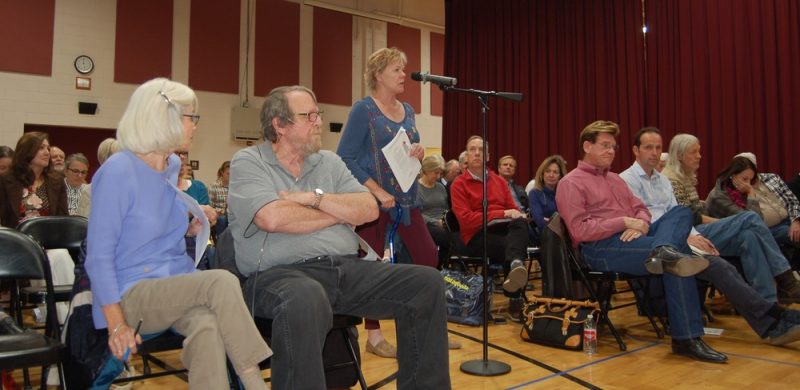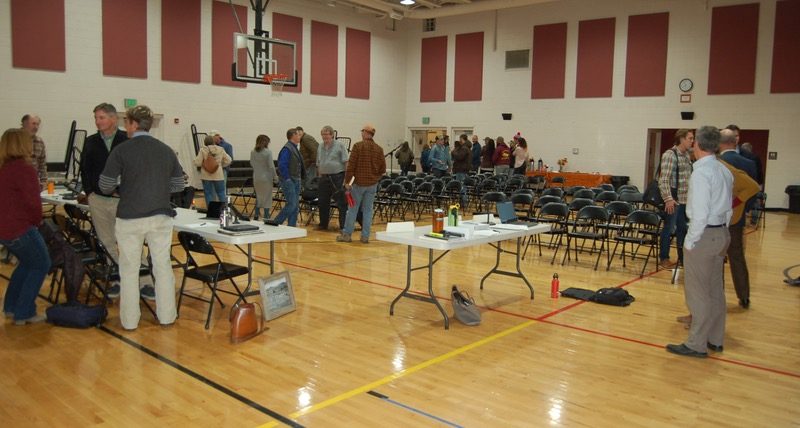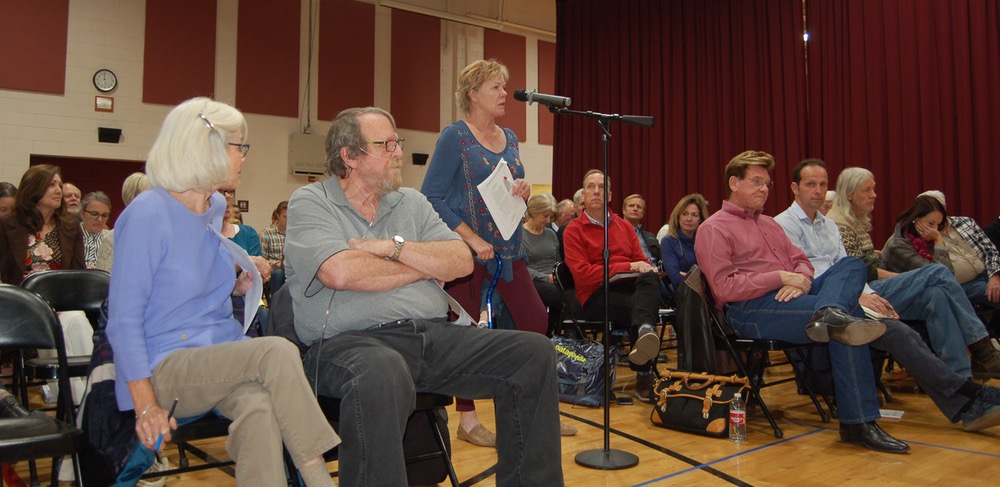I counted about 100 people in the audience at last night’s Pagosa Springs Town Council meeting at the Ross Aragon Community Center, one of the largest turnouts I’ve seen for a regular Council meeting in my 15 years as a political reporter here in Pagosa. Folks had come to testify for or against the creation of an Urban Renewal Authority (URA), or to listen to other audience members testify — and some stayed to the very end to see how the Council voted on the issue.
You can download the meeting packet here.

The vote, at the end of the meeting, was four in favor of forming a URA — Mayor Don Volger and Council members Nicole DeMarco, Tracy Bunning and Maddie Bergon — and three opposed — Council members Mat deGraaf, David Schanzenbaker and Matt DeGuise.
The testimony from the audience broke down in similarly close numbers, with 11 people speaking generally in opposition — to the URA and/or the proposed Springs Resort expansion project that brought the URA issue to last night’s vote. 10 audience members spoke generally in support. Mayor Volger asked the speaker to try and limit their comments to five minutes, but he didn’t cut people off if they went over five minutes. The Mayor assured everyone that the Council wanted to hear their comments, no matter where they stood on the issue.
Most of the speakers clocked in at under five minutes, although a few went over the suggested limit.
One of the shortest comments, but perhaps the most pertinent, was offered by local activist Lynne Vickerstaff, executive director of Pagosa Housing Partners. Her comments were pertinent, in the sense of addressing the most pressing issue in the community — an issue that, in 2019, has a substantial bearing on hotel expansion projects that would almost certainly create more low-paying jobs in an already struggling community.

“The point I want to bring up is that economic development is a wonderful thing,” Ms. Vickerstaff began, “but we need to keep in mind that we need to house the people we’re going to create jobs for. Whatever kind of jobs we’re trying to attract.”
She pulled out a cardboard rent calculator produced by the Colorado Housing Finance Authority (CHFA).
“If we are creating jobs in future projects that are paying around $15 an hour, the rental rate that someone can afford is about $780 a month. So as we think about bringing in jobs, and what kinds of jobs they are, we need to make sure there’s a housing opportunity for people coming into our community. Thank you.”
To put $15 per hour into some kind of perspective, I will share a story about a friend of mine who has 30 years of retail sales experience here in Pagosa Springs. She interviewed for a job at Natural Grocers, opening soon at the corner of Highway 160 and South 8th Street. She was offered a job… at $12 an hour.
Typical rent for a one-bedroom, in last week’s Pagosa Springs SUN classifieds, was about $1,000 a month — close to twice what a person making $12 an hour can afford for housing while still meeting their other needs, and staying out of debt.
The testimony in favor of creating an Urban Renewal Authority generally focused on the idea that any development is probably good development. That Pagosa must grow. That it’s good government policy to subsidize developers with tax reimbursements — and that anyone who believes otherwise is harboring unreasonable fears about the future.
The testimony in opposition was quite a bit more varied and interesting. A couple of folks spoke on behalf of the bird populations that thrive in the wetlands just south of the Springs Resort. One gentleman warned that the vacant travertine meadow adjacent to the Springs Resort is known to emit sulfurous gases and a development there might endanger the health of residents, if housing were built on the vacant property. Several people questioned the propriety of a Town Council extracting tax revenues from other government agencies — without their consent — to serve Town Council priorities. Some questioned whether ‘more development’ will ultimately create the kind of community we moved here to enjoy. A couple of people asked why a decision of this magnitude was not put before the voters. A couple of others expressed concern that several Colorado communities have dissolved their URAs in recent years, or limited the use of Tax Increment Financing (TIF) and we don’t know what drove those communities to take those actions.
We also heard a couple of presentations by the Town’s Denver-based attorney, Bob Cole, clarifying procedural points and generally extolling the virtues of Urban Renewal Authorities in Colorado.
The meeting had started at 5pm, and by the time came for the actual Council vote at around 8:30, most of the audience had already left. A few people volunteered to help the Town staff put away the folding chairs. Others stood around chatting about the outcome.

Prior to the Council vote, Mayor Volger invited each Council member to express their feelings about the issue and handed around the microphone. The intentions of the four Council members voting in favor of forming a URA could perhaps be best summarized by comments offered by Council member Maddie Bergon prior to the vote.
“Thank you, everybody, for coming out tonight. This is really awesome to see, as a Council member, to look out at a full audience and hear everybody’s voices, from the community. So thank you for taking the time to come out tonight.
“I view the formation of a URA as an equitable partnership between the public and private sectors to help move desired projects forward. And that could be at a pace faster than what the public sector is able to do, and it might be a little bit slower than what the private sector is able to do. But I think, with partnership, we can really see some desired projects moving forward, and hopefully more involvement from the community if we do move forward with this. I’d like to see this level of involvement continue. That’s kinda what my thoughts are, summarized.”
My favorite Council comment, in opposition to forming a URA, came from Council member Mat deGraaf. Straight and to the point.
“I feel both honored and grateful to be up here, and also a little intimidated. This is… there’s a lot going on. It’s hard for me to wrap my head around it. But the biggest thing that I can’t wrap my head around is that the success of a project can hinge on us finding it to be ‘blighted’ or ‘slum’ or ‘dangerous to public health and safety.’
“I look around my community and I can’t see that. Regardless of what definition you want to use for [‘blight’], I think the success of a project should be based on its merits and its contributions to the community… so I would rather see a different tool used to help move projects forward.”

